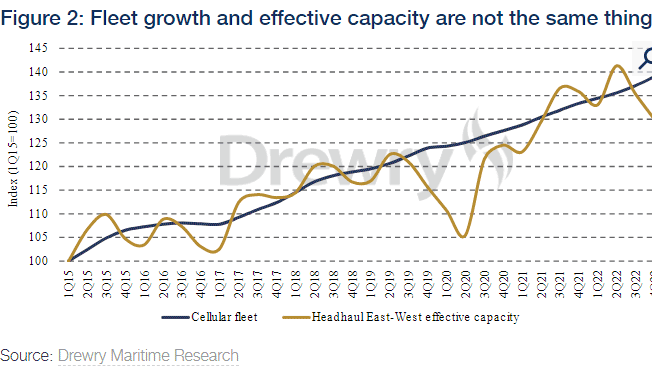Many ocean container carriers are starting to take deliveries of new ships for orders made in 2021 or 2022, forcing to lines to try to find ways to put the ships into action without adding to current supply-demand woes.
According to a new log post by the maritime analysts at Drewry, “the weight of the containership orderbook is tipping the balance of the market out of carriers’ favor, adding “We also been very clear that we expect carriers to take steps to mitigate this process.”
Supply Chain Digest Says... |
 |
|
| With slow-steaming, there is the opportunity mentioned above to absorb surplus ship capacity, which has the indirect potential of lifting revenues from higher freight rates. |
|
 |
|
What do you say? |
|
| Click here to send us your comments |
|
| |
|
| Click here to see reader feedback |
|
|
|
How would the lines do that?
Drewry notes when newbuild deliveries arrive, carriers have a choice to make about where to deploy them.
Then having selected a trade route, there are more decisions to take. Should they be added to an existing service, or an entirely new one? If they are going to an existing loop, what to do with any displaced units?
Such decisions are easier in a growing market as trades will require additional capacity to match increased demand. But for carriers right now, sadly demand is receding practically everywhere, so too are the viable cascading opportunities.
Drewry observes that in a down market such as we have currently, the imperative for carriers is to find creative ways to hide effective capacity so that utilization and freight rates aren’t driven still lower.
A favored technique is one we’ve seen before; “super-slow steaming.” More and more Drewry says, extra ships being added to existing services, extending round voyages, but crucially not the amount of effective capacity of the service.
The latest to adopt this strategy is the 2M carriers Maersk and MSC, which are adding a total of nine ships to eight Asia-Europe (including Med) services.
Increasing the number of ships without increasing the effective capacity might seem difficult, but Drewry includes some analysis that shows that regardless of the number of ships deployed, by extending the round voyage duration, either by slowing ships down or inserting new ports calls, or a combination of the two methods, carriers can find space for new ships without moving the supply-demand needle.
Drewry says it kept its analysis, simple as possible, but to arrive at the “true” effective capacity of a service and a given trade in aggregate, you should also would also make an adjustment for estimated capacity allocated to other routes (such as the Middle East on an Asia-Middle East-North Europe loop, known as wayports).
(See More Below)
|
CATEGORY SPONSOR: SOFTEON |
|
|
|
|
|
The key point, Drewry says, is that changes to the cellular fleet is only one (albeit important) variable when predicting what the real-world effective capacity will be. As the chart shows, while the two broadly move in the same direction, there are plenty of ways and means to divert effective capacity from the path.

So-called slow-steaming is just one of the many capacity reducing measures available to carriers, including slippage (delaying newbuild deliveries), blank voyages, demolitions and idling. While it is clearly a sub-optimal use of assets, it has its upsides, otherwise why would carriers employ the strategy?
With slow-steaming, there is the opportunity mentioned above to absorb surplus ship capacity, which has the indirect potential of lifting revenues from higher freight rates (or at least preventing further price erosion). There are also cost savings to be had from slowing down ships by reducing the gross service round voyage fuel usage.
However, Drewry says that there is no danger to shippers that temporary measures such as slow-steaming or blanking scheduled vessels could on their own create sufficient shortages to drive up rates significantly. This is because, fundamentally, the capacity is stored on tap ready to be released if demand picks up, or if/when carriers lose discipline.
Netting it out, Drewry says that “Carriers will utilize “inefficiencies” (less productive use of assets) to wage war on the daunting overcapacity problem. Cargo owners” should prepare for longer lead times as the trend of slower services is gaining momentum.”
What are your thoughts on more slow steaming? Let us know your thoughts at the Feedback section below.
Your Comments/Feedback
|

